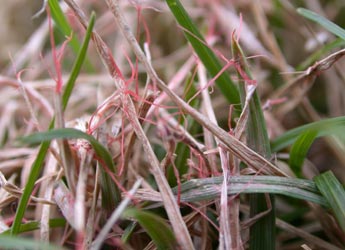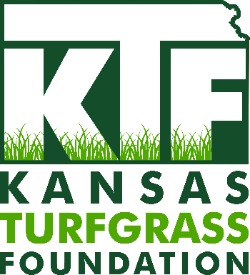Red Thread (Laetisaria fuciformis)

Red Thread is a foliar disease that usually occurs on taller mown turfgrasses during spring and fall. The effects of the disease are largely cosmetic: crowns and roots are not infected, therefore plants are not killed, and the turf eventually will recover. Red thread symptoms contribute to a generally undesirable appearance. Red thread takes its name from the antler-like structures (sclerotia) produced by the fungus (Laetisaria fuciformis) on the tips of affected leaf blades. The red or pink sclerotia are apparent without magnification and are useful in the identification of the disease in the field. From a distance, red thread symptoms appear as circular patches of tan or pink turf ranging from 4” – 8” in diameter. Kentucky bluegrass, perennial ryegrass, and tall fescue are most commonly affected by red thread.
Occurrence
Red thread development is favored by poor turfgrass nutrition and other factors that promote slow growing turf. Deficient levels of nitrogen fertility can promote serious outbreaks. Disease development occurs over a relatively wide range of cool, mild conditions (40 ° – 70 ° F), typically in the spring and fall of the year, especially when long evening dew periods occur.
Non-Chemical Control
Genetic resistance to red thread infection is limited. The most important non-chemical (cultural) control option involves the implementation of an adequate and balanced nitrogen fertility program. A good fertility program implemented over two to three years will drastically reduce or eliminate further red thread problems. Other cultural practices that keep turf healthy and vigorously growing also help suppress red thread. Also, avoidance of irrigation practices that extend dew periods (late afternoon, early evening) will contribute to a reduction in red thread outbreaks.
Chemical Control
Fungicides are not advised for red thread control on home lawns for various reasons. A red thread outbreak signals a more immediate problem with the health and vigor of the lawn. In almost all cases, practices that result in a well-nourished lawn also will result in suppression of red thread development. Also, most effective chemicals are not labeled for use by home owners and are difficult to apply properly. A licensed professional applicator should be used to apply most fungicides, thereby increasing treatment costs. Finally, the turf will recover to some extent with even a modicum of care because red thread does not affect the turfgrass crowns and therefore usually does not kill the plants.



